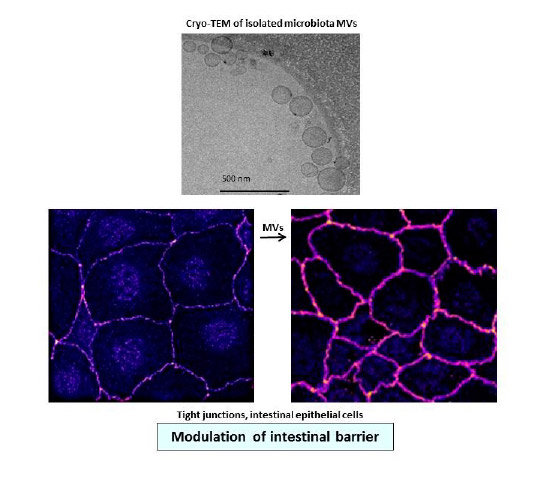Gut Microbiota-host Interaction
Department of Biochemistry and Physiology
Faculty of Pharmacy and Food Sciences, UB
Laura Baldomà Llavinés
ORCID ID: 0000-0002-7678-269X
Tel +34 934034496
Josefa Badía Palacín
ORCID ID: 0000-0003-0768-5033
Tel +34 934024533
https://www.ub.edu/portal/web/dp-bioquimicaifisiologia/interaccio-microbiota
Principal investigators: • Laura Baldomà Llavinés • Josefa Badia Palacin
Researcher: • Rosa Giménez Claudio
PhD student (CONICYT, Chile fellowship): • Natalia Diaz Garrido • Rodrigo Vera García


Current
Research
Understanding the complex interactions between intestinal microbiota and the host is a main goal of our research. The intestinal ecosystem relies on dynamic and reciprocal interactions between microbiota, the epithelium and the immune system. Our research is focused to the bacterial factors that mediate microbiota effects. Factors secreted by microbiota can diffuse through the mucin layer and reach the cells at the intestinal mucosa. All bacteria release extracellular membrane vesicles (MVs) to communicate with the environment. These vesicles allow secretion of selected proteins and active compounds in a protected environment, allowing long distance communication. We aim to elucidate the role of microbiota vesicles as key effectors in the regulation of intestinal homeostasis, especially in the modulation of the intestinal epithelial barrier and immune responses.
Our experimental models are: (i) human intestinal epithelial cell lines and immune cells (PBMCs, lymphocytes and dendritic cells), cultured either as single cells or in co-culture; and (ii) DSS-induced colitis murine model. Cell responses are analyzed by flow cytometry, RT-qPCR, immunodetection and confocal fluorescence microscopy. Now we are applying high-throughput screening methods to identify MV-regulated genes in dendritic cells, with specific attention to miRNAs. Our research, funded by Spanish Ministry programs co-financed with European Commission ERDF funds, is unravelling molecular mechanisms involving microbiota vesicles, contributing to a better characterization of the complex interaction between gut microbiota and the host.
Our group is also integrated into the Consolidated SGR Group on Integrative Biochemistry (Generalitat of Catalonia), whose principal investigator is the IBUB member M. Cascante. Both groups collaborate in the characterization of anti-cancer drug targets and anti-inflammatory activity of natural compounds in the framework of industry and international projects.

Selected
Publications
Cañas, M. A.; Fábrega, M. J.; Giménez, R.; Badia, J.; Baldomà L. Outer membrane vesicles from probiotic and commensal Escherichia coli activate NOD1-mediated immune responses in intestinal epithelial cells. Frontiers in Microbiology. 9:498, 2018. doi.org/10.3389/fmicb.2018.00498
Fábrega, M. J.; Rodríguez-Nogales, A.; Garrido-Mesa, J.; Algieri, F.; Badia, J.; Gimenez, R.; Gálvez, J.; Baldomà, L. Intestinal anti-inflammatory effects of outer membrane vesicles from Escherichia coli Nissle 1917 in DSS-Experimental colitis in mice. Frontiers in Microbiology. 8:1274, 2017. doi.org/10.3389/fmicb.2017.01274
Cañas, M. A.; Giménez, R.; Fábrega, M. J.; Toloza, L., Baldomà, L.; Badia, J. Outer membrane vesicles from the probiotic Escherichia coli Nissle 1917 and the commensal ECOR12 enter intestinal epithelial cells via clathrin-dependent endocytosis and elicit differential effects on DNA damage. PLoS One. 11(8):e0160374, 2016. doi.org/10.1371/journal.pone.0160374
Fábrega, M.J.; Aguilera, L.; Giménez, R.; Varela, E.; Cañas, M.A.; Antolin, M.; Badia, J.; Baldomà L. Activation of immune and defense responses in the intestinal mucosa by outer membrane vesicles of commensal and probiotic Escherichia coli strains. Frontiers in Microbiology. 7:705, 2016. doi.org/10.3389/fmicb.2016.00705
Alvarez, C. S.; Badia, J.; Bosch, M.; Giménez, R.; Baldomà, L. Outer membrane vesicles and soluble factors released by probiotic Escherichia coli Nissle 1917 and commensal ECOR63 enhance barrier function by regulating expression of tight Junction proteins in intestinal Epithelial Cells. Frontiers in Microbiology. 7, 2016. doi.org/10.3389/fmicb.2016.01981
Selected
Publications
Author
Cañas, M.A.; Fábrega, M.J.; Giménez, R.; Badia, J.; Baldomà L.Identification
Front. Microbiol. 9:498, 2018. doi: 10.3389/fmicb.2018.00498.[/su_spoiler] [su_spoiler title="Intestinal anti-inflammatory effects of outer membrane vesicles from Escherichia coli Nissle 1917 in DSS-Experimental colitis in mice. " open="no" style="default" icon="plus" anchor="" class="selected-publications-toggle"]Author
Fábrega, M.J.; Rodríguez-Nogales, A.; Garrido-Mesa, J.; Algieri, F.; Badia, J.; Gimenez, R.; Gálvez, J.; Baldomà, L.Identification
Front. Microbiol. 8:1274, 2017. doi: 10.3389/fmicb.2017.01274.[/su_spoiler] [su_spoiler title="" open="no" style="default" icon="plus" anchor="" class="selected-publications-toggle"]Author
Identification
Cañas, M.A.; Giménez, R.; Fábrega, M.J.; Toloza, L., Baldomà, L.,; Badia, J. Outer membrane vesicles from the probiotic Escherichia coli Nissle 1917 and the commensal ECOR12 enter intestinal epithelial cells via clathrin-dependent endocytosis and elicit differential effects on DNA damage. PLoS One 11(8):e0160374, 2016. doi: 10.1371/journal.pone.0160374.
[/su_spoiler] [su_spoiler title="" open="no" style="default" icon="plus" anchor="" class="selected-publications-toggle"]
Author
Identification
Fábrega, M.J.; Aguilera, L.; Giménez, R.; Varela, E.; Cañas, M.A.; Antolin, M.; Badia, J.; Baldomà L. Activation of immune and defense responses in the intestinal mucosa by outer membrane vesicles of commensal and probiotic Escherichia coli strains. Front. Microbiol. 7:705, 2016. doi: 10.3389/fmicb.2016.00705.
[/su_spoiler] [su_spoiler title="" open="no" style="default" icon="plus" anchor="" class="selected-publications-toggle"]
Author
Identification
Alvarez, C.S.; Badia, J.; Bosch, M.; Giménez, R.; Baldomà, L. Outer membrane vesicles and soluble factors released by probiotic Escherichia coli Nissle 1917 and commensal ECOR63 enhance barrier function by regulating expression of tight Junction proteins in intestinal epithelial cells. Front. Microbiol. 7:1981, 2016. doi: 10.3389/fmicb.2016.01981
[/su_spoiler] [su_spoiler title="" open="no" style="default" icon="plus" anchor="" class="selected-publications-toggle"]

